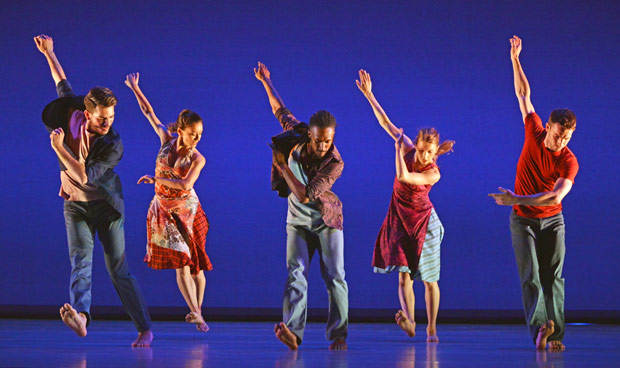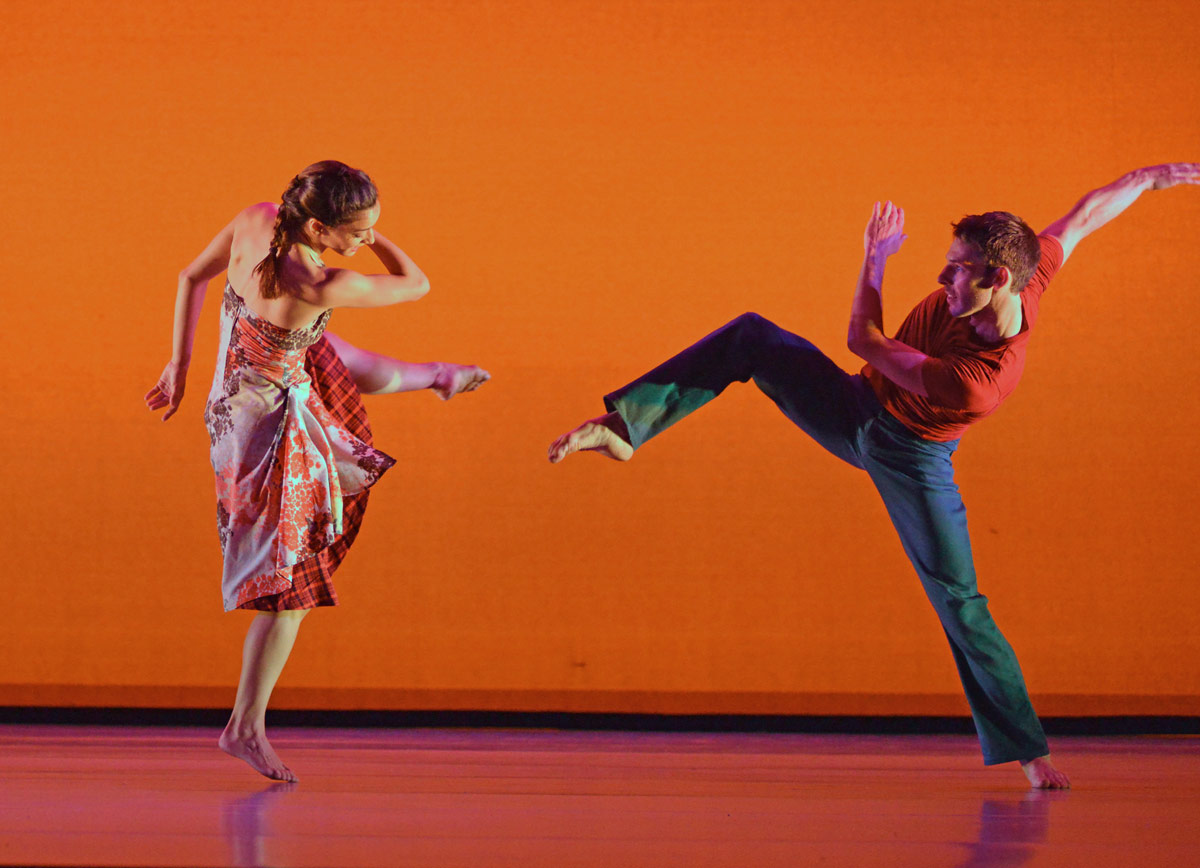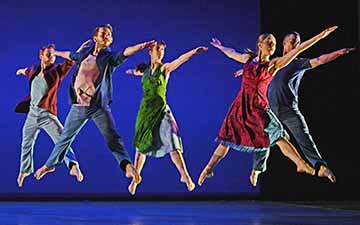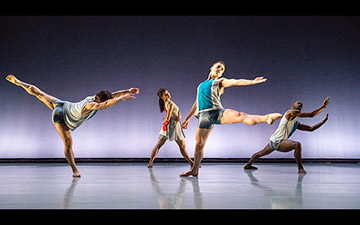
© Dave Morgan. (Click image for larger version)
Richard Alston Dance Company
Glint, Tangent, Chacony, Gypsy Mixture
★★★★★
London, Sadler’s Wells
16 June 2017
Gallery of Gypsy Mixture pictures by Dave Morgan
www.richardalstondance.com
sadlerswells.com
For the first time in his long career of matching movement to music – one that is very soon to reach its half-century anniversary – Richard Alston has found inspiration from the same composer for a third successive time. Following Phaedra and Rejoice in the Lamb, Alston’s love for the music of Benjamin Britten has inspired this London premiere of Chacony.
This love affair began, in 1962, when Alston first heard Britten’s War Requiem on the wireless during the consecration of Coventry Cathedral. Although this is one Britten composition that Alston has vowed never turn into choreography: “It is music that just makes you want to stand still and listen”, he told me, in preparation for the programme notes for this show. It so happens that Alston’s Chacony has an elegant, flowing, highly-finessed beauty that just makes you want to sit still and watch. The synergy between composer and choreographer is profound.
Britten’s Chacony might also be regarded as an act of remembrance, since it is the third movement of his Second String Quartet, which was composed just a few weeks after Britten had completed the strangest and most poignant concert tour of his life; performing with the virtuoso violinist, Yehudi Menuhin, in the Displaced Persons’ Camps that housed survivors of the Holocaust. On 27 July 1945, for example, they played two concerts at Bergen-Belsen. The experience was so traumatic that Britten would not discuss it for many years. Instead, he let the strings speak for him.

© Dave Morgan. (Click image for larger version)
The Second String Quartet also honoured Henry Purcell and it was first performed to mark the exact 250th Anniversary of his death (21 November 1945). Uniquely, Purcell used the term chacony, instead of the more usual chaconne, and – in 1948 – Britten took his admiration for Purcell one step further by orchestrating the latter’s Chacony in G Minor, for strings. It is the combination of Britten’s realisation of Purcell’s work, followed by his own Chacony that provides the haunting music for a masterpiece of Alston’s own making.
Chacony is a work of intense elegance, sentimental beauty and melancholic reflection; initially danced by ten dancers, wearing deep crimson robes, forming curved lines and sophisticated, fractal patterns; sweeping softly through stately algorithms that visualise the baroque themes in Purcell’s music. By contrast, the Britten Chacony is performed by dancers in dull, grey costumes and its centrepiece is a moving, sensitive duet between Liam Riddick and Elly Braund, conveying an overwhelming feeling of shyness and withdrawal.
The work’s conclusion has the ensemble linked together by their hands, and then twisting to face away from the audience. It is an enigmatic moment that seems to echo the sentiment of never forgetting, whilst deriving optimism for the future from the uplifting impact of Britten’s major key chords. Britten tells us that the human spirit will fight on; and Alston reflects that determination in his closing imagery. As Alston approaches his 50th year as a choreographer, Chacony proves that he is still creating his best work.

© Dave Morgan. (Click image for larger version)
Alston’s company is firmly based on his own choreography, augmented only by the work of Martin Lawrance, who brought another London premiere to this particular evening; with Tangent, a piece inspired by Astor Piazolla’s Las Cuatro Estaciones Porteñas (the Four Seasons of Buenos Aires), in a piano arrangement by Marcello Nisinman, played live on stage by Jason Ridgway.
Lawrance’s contemporary take on tango works very effectively (it is certainly up there alongside Sidi Larbi Cherkaoui’s Milonga) with four couples building up layers of intensity to match the explosive energy from the piano. Tangent is a sexy and optimistic work that plays with the iconic whiplash and leg hooks of tango; but – on this evening – it was also a moment of bittersweet sadness since Nancy Nerantzi, the very essence of Argentine allure, was performing for the last time with the company, prior to joining Rambert.
The programme had opened with Alston coming onto the stage to announce a special curtain-raiser that was not included in the original schedule. He had made a brief work, entitled Glint, on twelve students from the Rambert School and – inspired by them – it had gone so well that he decided to bring it to a bigger audience. It is a fast-paced romp through John Cage’s Second Construction for Percussion, performed superbly by these excellent young dancers, including Connor Scott, the winner of the BBC Young Dancer in 2015.

© Dave Morgan. (Click image for larger version)
The programme ended with a revival of the ebullient and uplifting Gypsy Mixture, a work made by Alston to the techno-infused remixed gypsy rhythms, featuring barking dogs and crying babies, which comprise the Electric Gypsyland CD. Thinking of Nerantzi’s imminent departure, this is a sequence of dances that I well recall another former dancer, Jonathan Goddard, fizzing through (you can still experience his performance, albeit on DVD).

© Dave Morgan. (Click image for larger version)
This is an entirely new generation of Alston dancers (only Nerantzi had ever performed it before) and – to their great credit – the new bunch were every bit as superb as the dancers on whom the work was created, with Nicholas Bodych especially inspirational in the role formerly danced by Goddard. The closing number – Lest Sexy – was an infectiously upbeat way to end an excellent programme; and – perhaps, also with the memory of those Rambert students – it was a timely reminder of the relentless renewal of great dance and great dance companies.

















You must be logged in to post a comment.